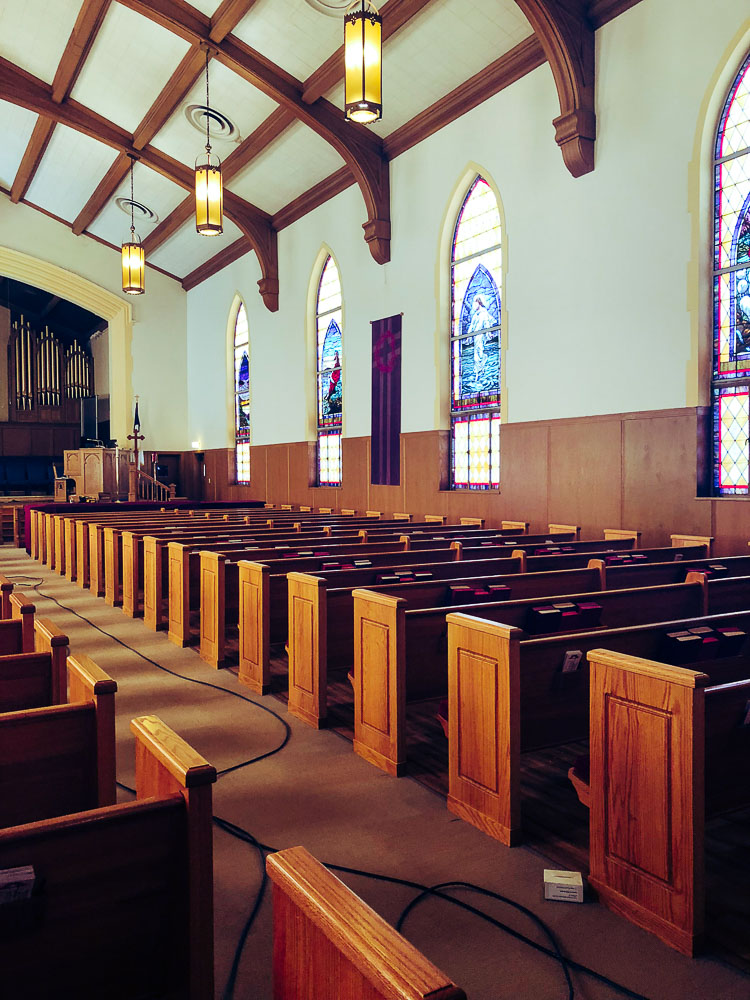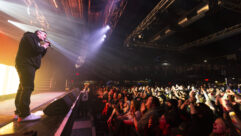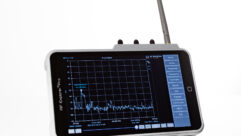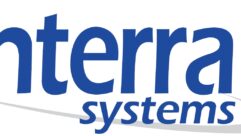SVC Podcast – Show Notes – Show 202-2
On this edition of the SVC Podcast, Contributing Editor Bennett Liles wraps up his conversation with Ian Burnell of Featherston Media. Ian details the sound upgrade done for the First United Methodist Church in Waxahachie, Texas with an AtlasIED BlueBridge Matrix DSP, Sennheiser Dual IK 300 IEM G3 monitoring system and he describes the installation of a backup power system for the new sound gear.
Links of Interest:
· Sennheiser Dual IK 300 IEM G3 monitoring system
· RCF HD10-A active speaker array module
· AtlasIED BlueBridge Matrix DSP
This is the SVC Podcast from Sound & Video Contractor with Ian Burnell of Featherston Media. We’ve got show notes and product links for this one and all of the other SVC podcasts at svconline.com. Just go to Podcasts at the top of the page.
Handling more than just AV but IT, telephones, security and cameras, Featherston Media in Waxahachie, Texas came into their local First United Methodist Church with a sound system revamp including all new mics, speakers and front of house mixer. Ian Burnell is back with us to wrap up that story coming up next on the SVC Podcast.
Ian, glad to have you back with us from Featherston Media. We were talking last week about the comprehensive and, from all appearances, much needed sound system upgrade for the First United Methodist Church in Waxahachie, Texas. An old building and you did the job in two phases including a power addition. Part of the job was the Atlas BlueBridge Matrix DSP. Why did you choose that one for this job?
It’s our go-to. They have different versions of that with 8×8 inputs, 8×16, 16×16, so they meet a whole array of solutions. And with this, when you talk about it being used at First United it allowed us to tune the system. So it allowed us to tune the choir monitors and the line array speaker easily and effectively and then it allowed us to add in delays into the RCF’s, the HDL-6’s. That’s why we went with that is we do it for all our projects. Basically it allows for future growth without being stunted at the very beginning so we won’t have to go back in and add something; let’s say if they want to add low-voltage speakers out in the foyer, we would be able to tie that all into that with BlueBridge DSP and be able to control it via the network. So that’s why we went ahead and went with that one. [Timestamp: 1:59]
Always an advantage if you already know the gear and the support from the company are both good. Where did you locate the equipment racks for that? I would think that even in a church they’re not right out there where just anybody can get to them.
No, sir. The way that FUMC’s sanctuary is, is they actually have a balcony. That’s where they have their sound booth table. And up there there’s actually a locked closet up to the left and that’s where we installed the rack. We installed an 18 U rack up there to house the DSP as well as all of the wireless equipment and a few pieces of additional equipment that we put in there for power redundancy and things like that. [Timestamp: 2:33]
And as we talked about last week, you included a Yamaha TF3 with a Dante interface card and the TIO1608D stage box. Was it mainly the operating features on the mixer or just the price that led you to the Yamaha?
Price was definitely a contributing factor, although when you look at the same style of console from different manufacturers they all typically stay within the same price. They’re all competitive. With this one it was the graphic user interface. It was very user-friendly. From them coming from an analog board and moving into a digital board, we wanted to kind of limit the learning curve, so to speak. And then Yamaha offers, like you said, the TIO1608D stage box and their Dante card. They allowed for us to implement a complete solution very easily and very seamlessly. So with that Dante card, it actually connects to the stage box, which provided them a digital snake via one CAT-6 cable run. So that immediately decreased the cost of copper that we would have had to use to install everything upstage. [Timestamp: 3:34]
You had to also make some power capacity addition for this. How did you build in power redundancy for the new sound system?
So with all systems we typically use something like a Furman Power Conditioner if we have amplifiers or IEM’s like that. With this one we went ahead and did a couple of cyber power backup battery UPS’s and tied them directly into an ATS power distributor. We do that with all our network upgrades as well so implementing that into the AV is exactly the same. With those backup battery UPS’s we actually had remote management cards in them and tied them into the network so we are fully capable of supporting the power, making sure that they are always online. And if something does happen we’re aware of it probably before they’re even aware of it so we’re able to take the correct steps in troubleshooting and ensuring that they have a smooth service; that power isn’t one of the things holding them back. [Timestamp: 4:30]

The church also needed wireless mics and you put in an IEM system. This is a fairly traditional outfit so how do they use the wireless mics?
When we got in there they were already utilizing a few wireless mics. They had an array of Shures or older Sennheisers that they were using. So we went ahead and just completely updated the old wireless mic system and that allowed us to even install a couple of active antennas and provide them with correct RS frequencies. So we were able to calibrate their entire wireless system to work the way it should and sound the way it should. And then we also added six of the Sennheiser in-ear monitors and then we put those into an 8-in-1 combiner. That overall was to be seamless and then it gave them the functionality, like everyone on stage could just use their smart phone to control their own monitors, which is very convenient and they definitely loved that. It was kind of a blessing because when you think of a traditional church they like to stay on the same path and they like to stick to their roots, but they were very open to this change when it came to the in-ear monitors and how to use them. They absolutely love it. It doesn’t take away from their overall worship experience. [Timestamp: 5:40]
That seems like the thing to do on this type of church in keeping it simple while adding just the modern features to give them control in the performance. They went from an old analog mixer to the digital Yamaha so did Featherston Media provide some initial training on the mixer?
With any project that we do, and this one in particular, we always provide training. So at Featherston Media we kind of design our systems to be a turnkey, but with a twist. So I guess if you were to put it in a metaphor, we give the key to the car but we’re there in the passenger seat with you. So when it comes to any project we do training before we go live. So for example they go live on a Sunday. Let’s say we finished that project on Wednesday. So Thursday night we would have training with a tech team for a couple of hours where we would just sit down with them, show them all the new equipment. So in this case it would have been the board and their in-ear monitors and things like that and how to control them. And then we were able to answer any questions there that they may have initially with just being there in person. And then on Friday we do a rehearsal or a run-through so we would have the band there as well as the pastor and we would kind of do a worship experience at what they would do that Sunday so they can practice with the new equipment. And the reason why we do that on Friday is because, for example, with FUMC on Friday that’s when we tuned the system and added in our delays and things like that. So when we do the rehearsal we’re able to make sure that that tuning is the way it’s supposed to be, that it’s all EQ’d properly. Then we run through a full run-through of what their Sunday will be just so they can kind of get a feeling of the changes. And then another advantage we have is on Sundays here in our office we actually have a support handler on site at our office monitoring all of our churches’ live streams, handling any tickets from 7:00 to 12:00. Because with churches they don’t get to use that equipment but once or twice a week so they don’t know about any problems until they happen on Sunday or on Wednesday night or whenever they have their experience. So we’re able to actually have someone here in the office to quickly handle any issues or problems that may arise. [Timestamp: 7:44]
Future proofing is always a consideration on these in case they later decide to modernize their services with some more live music. What did you build into this to allow them to have some room to grow?
With the HDL-6’s, l mean, one bar can hold upwards of 16 actual speakers. So in designing the system we knew that the HDL-6’s were versatile enough to be capable of growth. So if they wanted to go more live music we could change the way the whole array was and just add in additional arrays, like maybe a left and a right instead of just a center hang. Also we could add in fills for the balcony and things like that. Then if you want to get into live music with adding instruments, with the Yamaha stage box it actually gave us an additional – I think it was 32 inputs and outputs onstage. So it allows for growth there as well without us having to come back in and penny pinch for additional equipment. When we design our systems we want to prevent that. [Timestamp: 8:43]

It would appear that you certainly got them all set up for now and to be able to grow into the future. So what does Featherston Media have coming up next?
We’ve got a few projects. Currently we’re doing a security and access control overhaul for a church here in Waxahachie called the Avenue Church. They’re currently adding a new education wing for their children so we’re doing all the access control and security cameras for that as well as all the cabling that they need for those classrooms. We’re working with a bunch of new IT and networking clients throughout the area and then we are apparently installing some projectors and speakers at some schools here in Waxahachie. If any of the listeners wanted to check any of our projects out they can actually visit our web site at FeatherstonMedia.com where we actually have articles on all of our most recent completed projects such as the First United Methodist Church one or even the most recent one we did with the Avenue Church where we did an LED video wall upgrade. As well as they can find our Instagram and Twitter and Facebook where we actually post regularly there progress posts of projects so they can see what’s going on on a day-to-day basis on some of our projects. [Timestamp: 9:52]
And among the links we have for this one is Featherston Media along with some links to specific gear used. We’re glad to have had you with us today. We’ve been talking to Ian Burnell of Featherston Media in Waxahachie, Texas about their complete sound renovation at the First United Methodist Church there. New RCF speakers, Sennheiser mics and Yamaha Front of House mixer. Good talking to you, Ian.
Thank you for having me.
Good to have Ian Burnell with us today from Featherston Media and the sound system renovation at the First United Methodist Church in Waxahachie, Texas.










